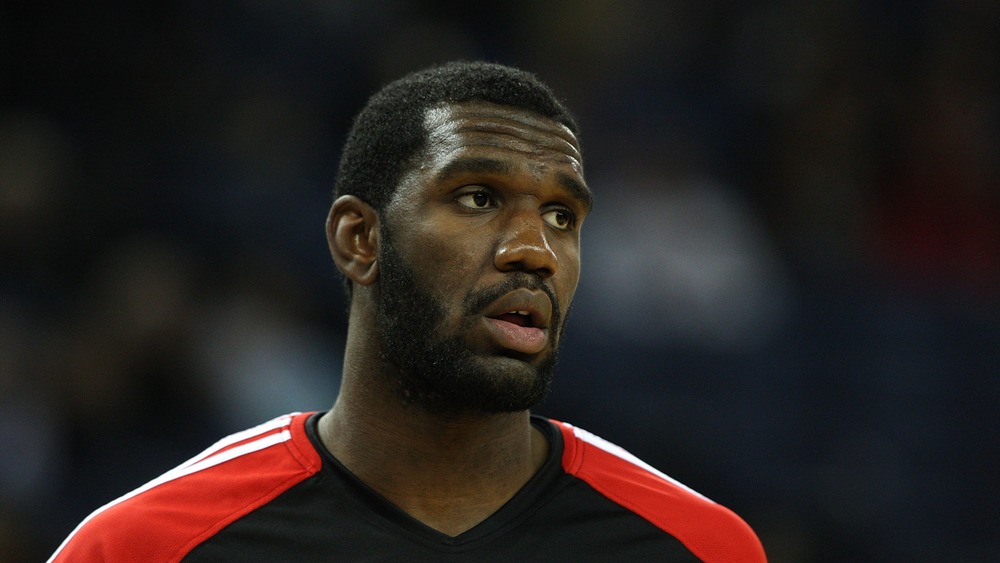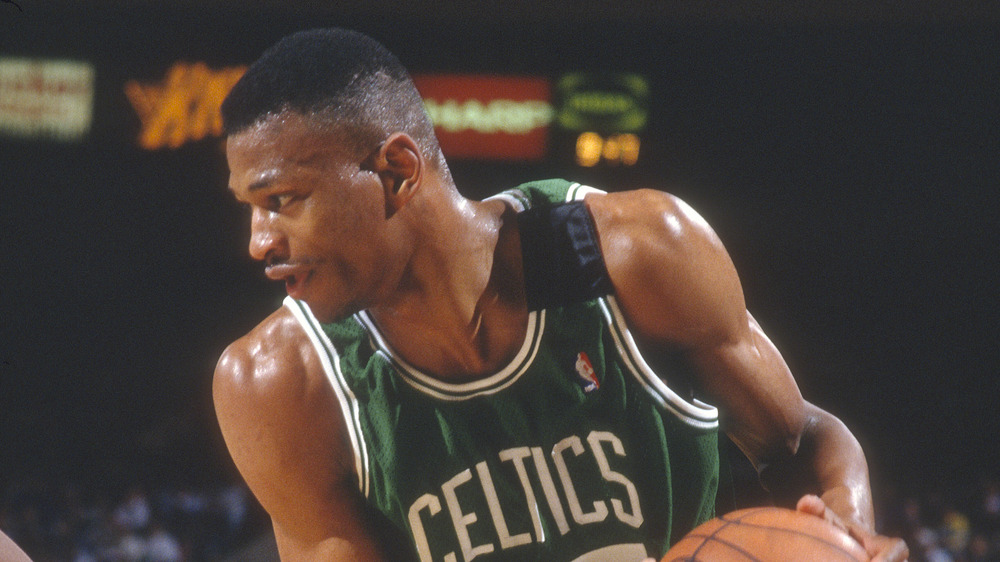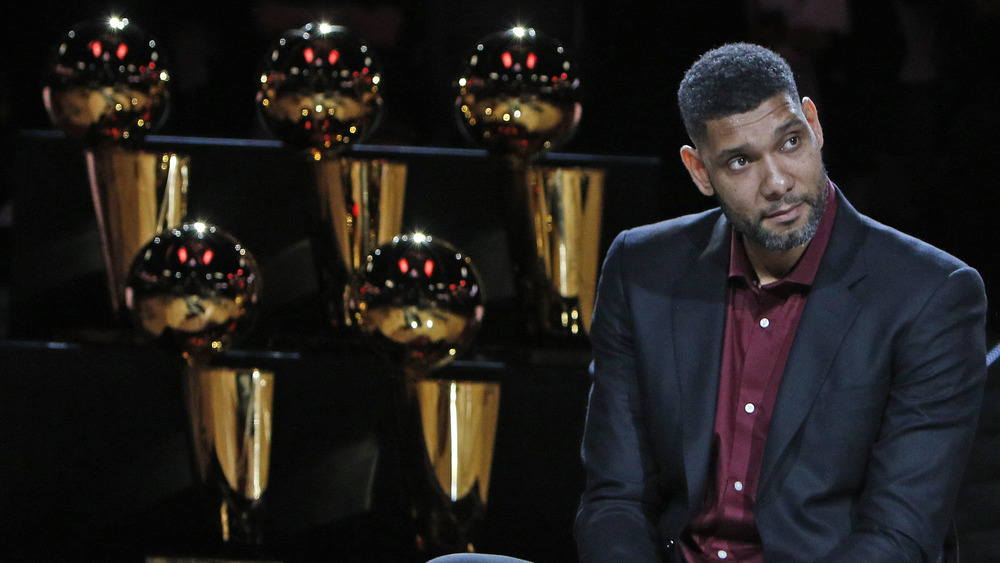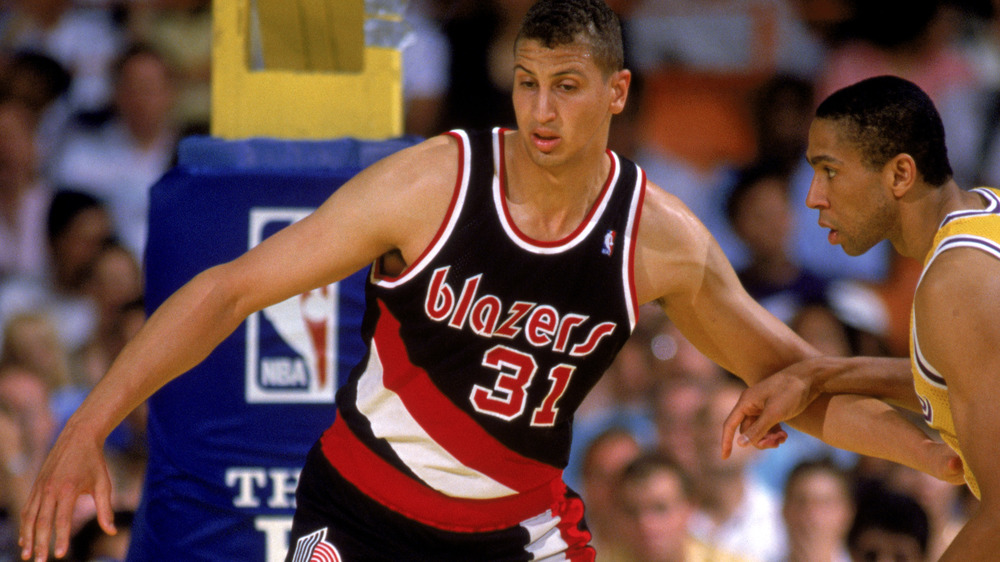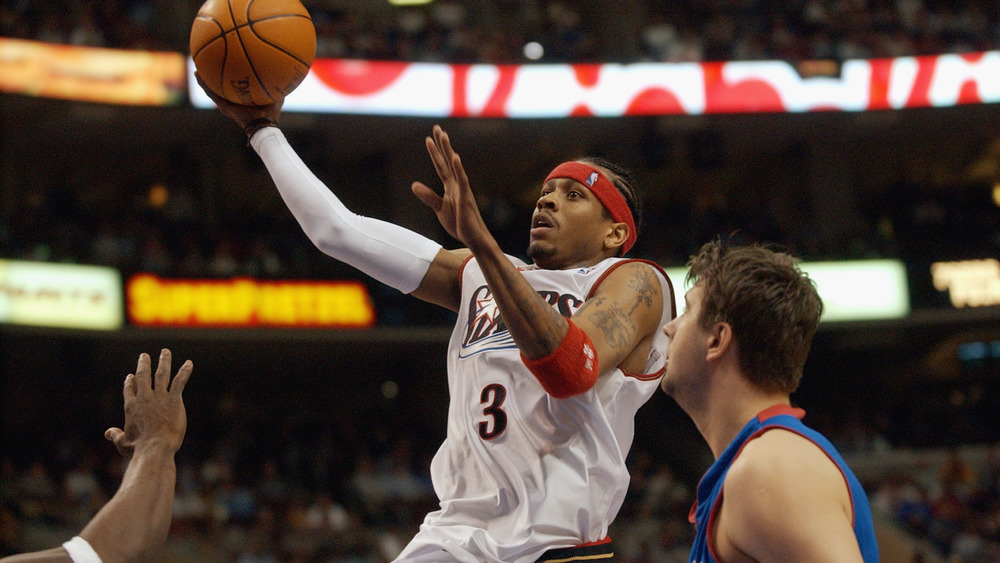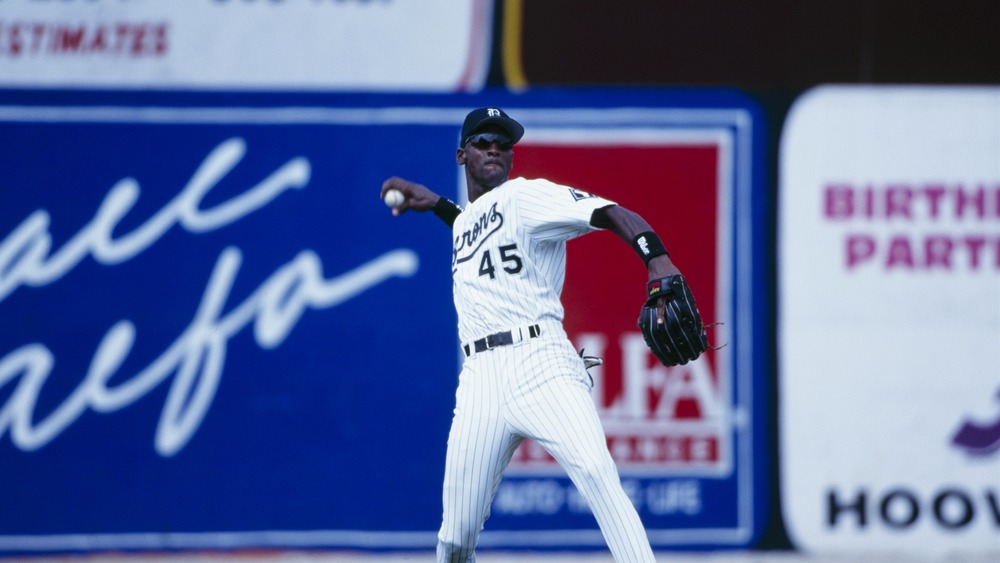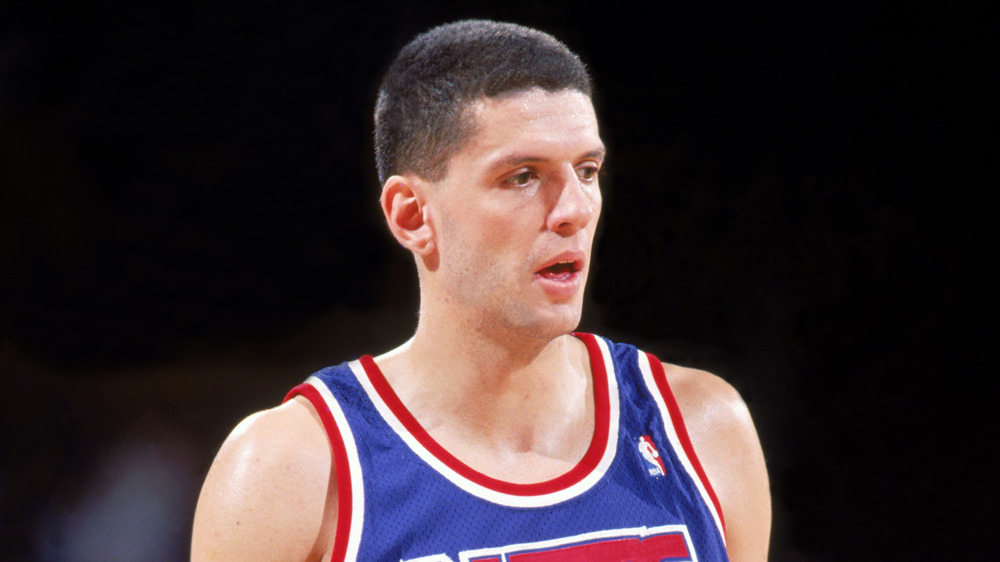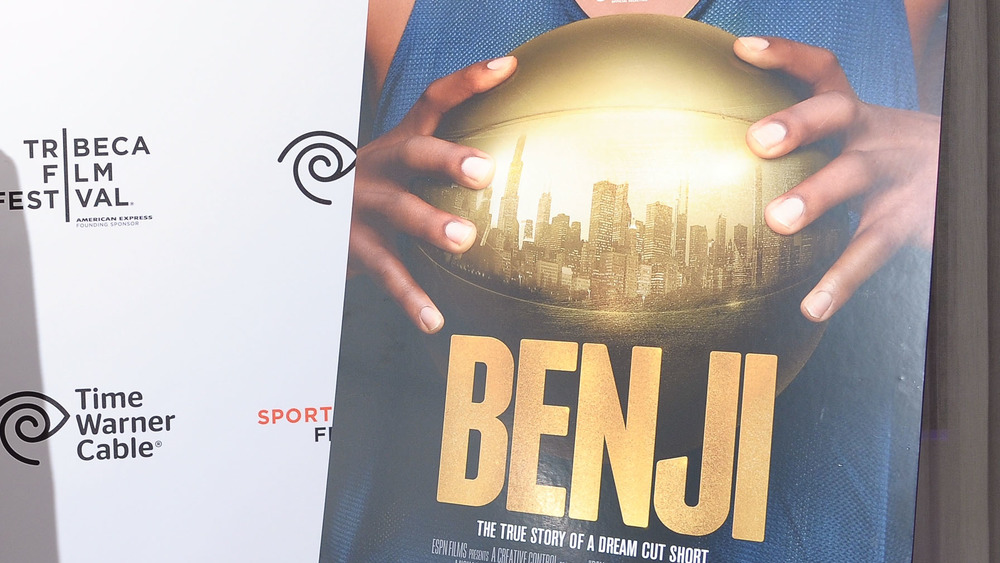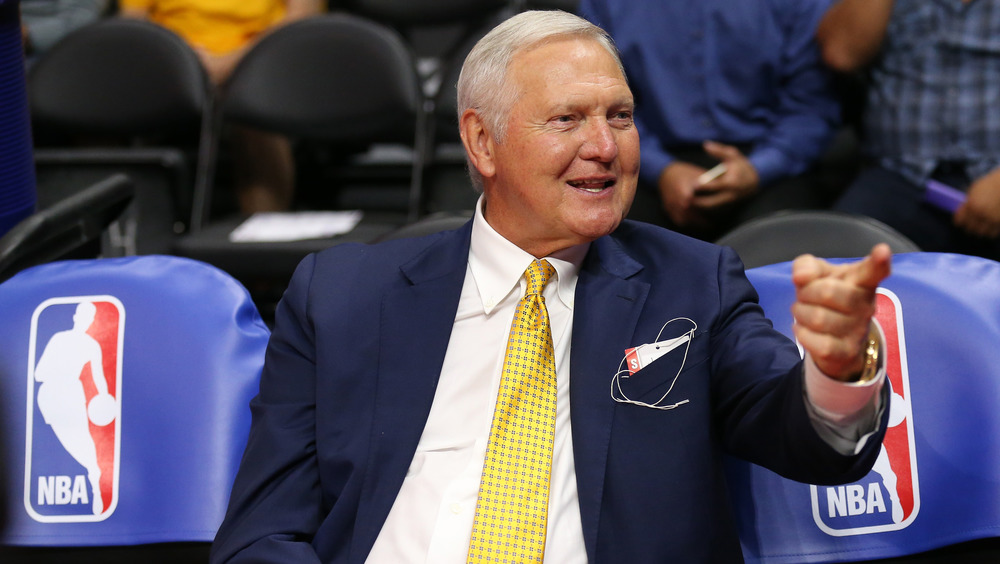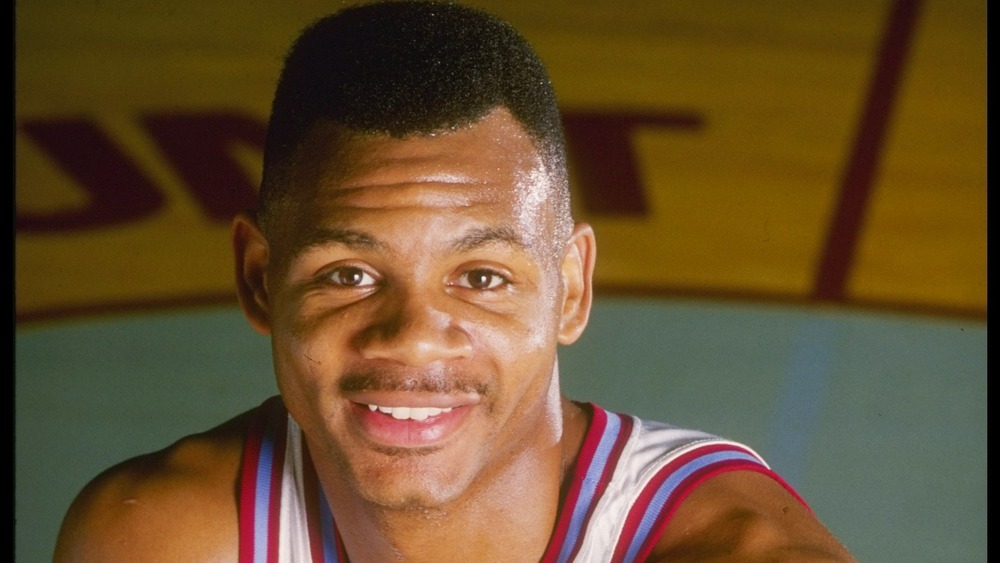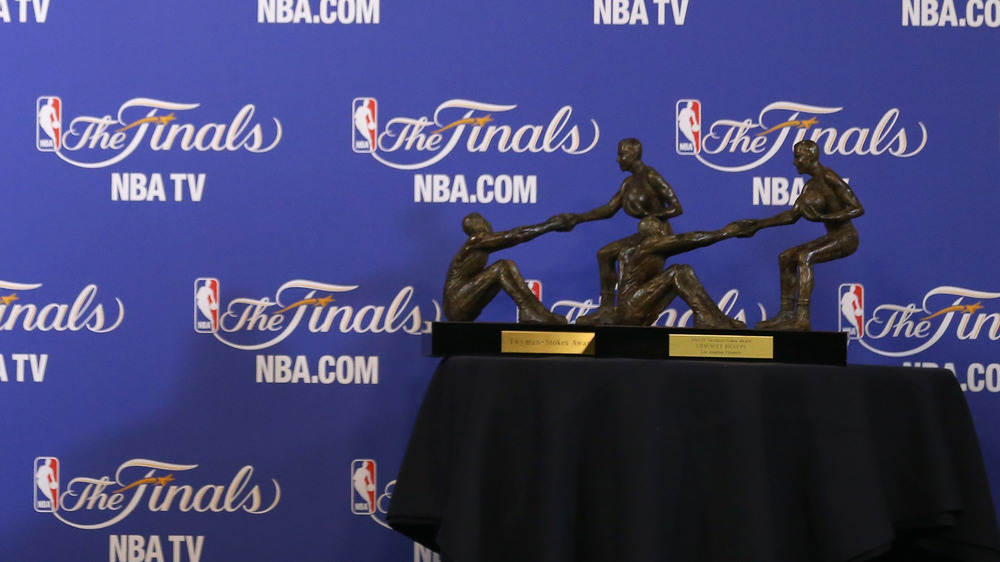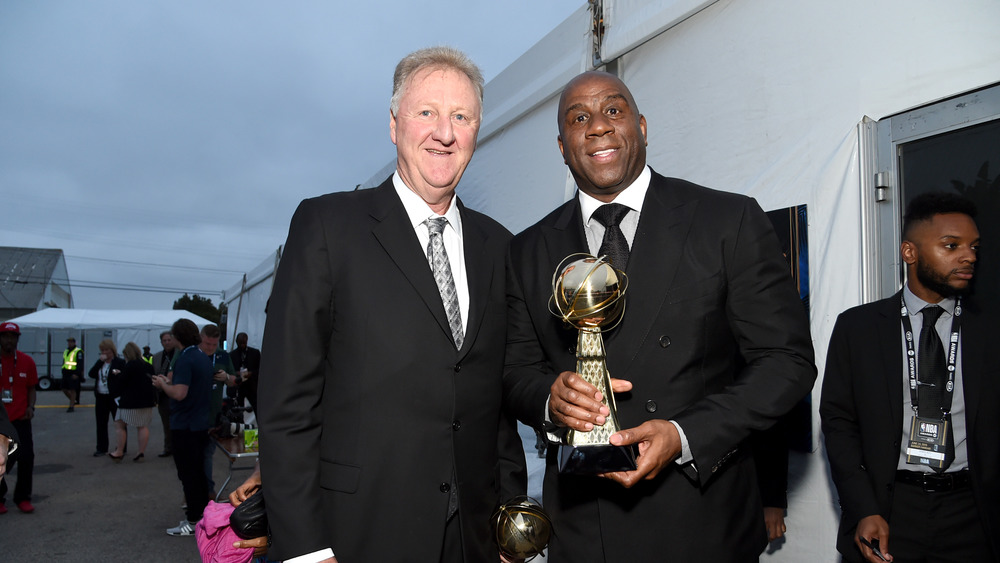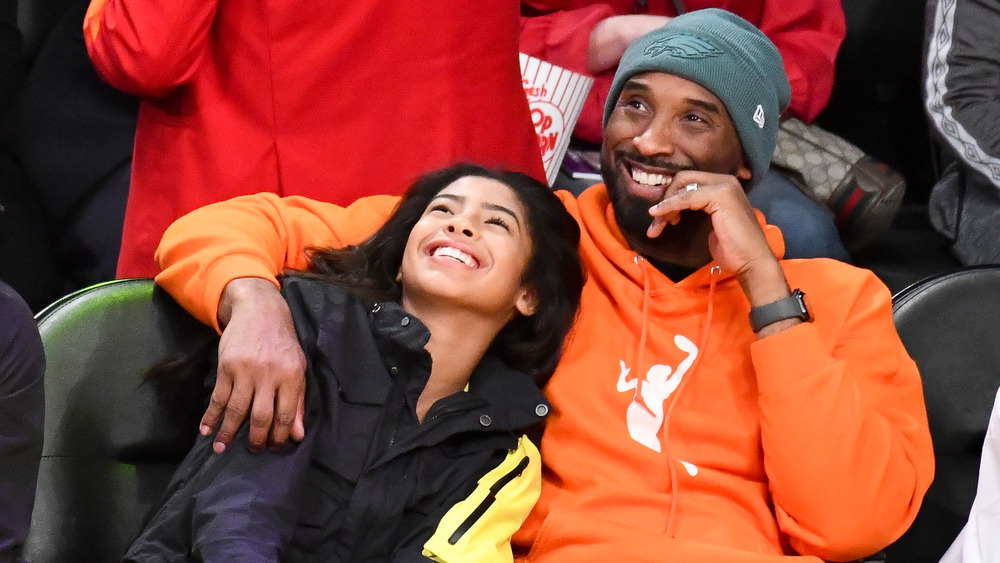Tragic Details About Basketball's Biggest Legends
It is hard to imagine that any of the young men at the International YMCA in December of 1891 would comprehend the popularity of the game their teacher created. According to Britannica, James Naismith and other faculty members devised a game to keep the boys active inside during the harsh Springfield, Mass., winter weather. Using peach baskets as targets, the first game of basketball was played.
Now, over a century after that first exhibition, the sport has become a global business and a multi-billion dollar industry. From toddlers barely able to walk to gray-haired seniors at the twilight of their life, the sport's popularity is unmatched by almost any other sport in the world.
This in large part is thanks to the stars whose abilities have attracted new fans to the sport generation after generation. From the dribbling exhibitions of the Harlem Renaissance and Globetrotters to the high school phenoms who put thousands into 500 seat gymnasiums, basketball stars have become like Broadway actors, dazzling their audiences with breathtaking performances each night.
For many players, the court is a sanctuary. Hidden away in their lockers are tragic backgrounds they wish to escape, such as depression and fear. Basketball becomes an escape for them. And for many players, the wear and tear of the game eventually forces them to give it up or suffer an even greater tragedy. Here are some tragic details about some of basketball's biggest legends.
The deaths of Len Bias and Reggie Lewis
The Boston Celtics of the 1980s were one of the greatest teams in NBA history. Winning three championships in a six-year span, the Celtics hoped to rejuvenate their aging core with fresh, young talent in the draft. Unfortunately, the two players who were meant to hold together the dynasty died before either could reach their full potential in the league.
In 1986, the Celtics were coming off their third championship of the decade and through shrewd maneuvering, held the second pick in the upcoming draft. Boston used the pick on Maryland forward Len Bias. According to USA Today, Bias' career in college led many to believe he could be the equal of another player from his conference, Michael Jordan. Jay Bilas, who played against Bias in college called him, "superman in a basketball uniform" and was heading to a Hall of Fame career. Two days following the selection, Bias would die of a cocaine overdose in a friend's dorm room. He was only 22.
While shaken, Boston had another hopeful youth in their next year's first-round pick, Reggie Lewis. According to Sportscasting, Lewis saw heavy minutes in his second year and never looked back. In a 1993 playoff game, Lewis collapsed for a moment on the court. At first, he received a diagnosis of focal cardiomyopathy before getting a second opinion that was not as serious. During an off-season workout, Lewis collapsed again and went into cardiac arrest. He was 27 when he passed away.
Fear and cancer pushed Tim Duncan to basketball
Tim Duncan's career was the model of quiet excellence. For 20 years, he led the San Antonio Spurs to five championships and retired as one of the game's greatest players. Like many great athletes, basketball was not his only love. According to Talk Basket, Duncan trained as a child to make the Olympics as a swimmer. The 6-foot 11-inch superstar said he would swim, "5,000 to 8,000 meters a day, six days a week." Sportscasting says that Duncan's sister, Tricia, competed in the 1988 Seoul Olympics. While training for the 1992 Olympics, a natural disaster ruined his chances.
Hurricane Hugo devastated Duncan's home of St. Croix and destroyed the only Olympic-sized swimming pool the island had. This forced the 13-year-old Duncan to swim in the Caribbean instead. However, these plans ended quickly as Duncan developed a fear of sharks, ending his swimming career.
During the same time, the Duncan family suffered a greater setback. His mother, Ione, was diagnosed with breast cancer. The day before his 14th birthday, Duncan had to say goodbye to his mother. According to Sports.Jrank, Duncan's older sister, Cheryl, and her husband Ricky Lowry, returned to the island to care for the family. Lowry, a former college basketball player, encouraged his brother-in-law to pick up the sport. The year prior, the couple shipped a basketball hoop to the family, and it survived the hurricane. Duncan picked it up, and with Lowry's coaching, never looked back.
History of injuries on Portland Trail Blazers
There might not be a more snake-bitten NBA franchise than the Portland Trail Blazers, and there might not be a more dangerous job than being a center for the Blazers. Since the 1970s, Portland's big men seemed to live on the injury list. The first to suffer was perhaps their greatest player, Bill Walton. According to ESPN, Walton missed only three games during his career at UCLA. However, in the NBA, Walton missed more games (680) from a nagging foot injury than he played in (488).
A few years after Walton left Portland, the Blazers decided to use their second overall pick on another big man, Kentucky's Sam Bowie. Seemingly a good pick, the Chicago Bulls held the third pick and selected a shooting guard from North Carolina named Michael Jordan. Oops!
Jordan became, well, Jordan, and like Walton, Bowie's short time in Portland was spent injured. ESPN's program, Top 5 Reasons You Can't Blame, said that Bowie's tibia fracture was so rare, only 16 cases could be found worldwide, and most were found in male ballet dancers.
Well, third times the charm they say! In the 2007 NBA Draft, Portland had the first pick and had to choose between Ohio State center Greg Oden and Texas forward Kevin Durant. Portland picked Oden, who played on 82 games in five seasons in Portland, suffering from a variety of injures, according to Bleacher Report. Durant, like Jordan, became a superstar and multiple-time champion. Sorry, Portland.
Allen Iverson's trial
Allen Iverson helped change the landscape of the NBA when he stepped into the league in 1996. According to SportsCentury, Iverson helped popularize hip hop culture and morphed the rigid, conservative NBA fanbase to the younger and more vibrant fanbase of today. As a teenager though, Iverson's entire life could have been altered after a controversial verdict in a racially charged trial.
In 1993, Iverson was a top football and basketball star at Bethel High School in Hampton, Va. According to NPR, that Valentine's Day, a massive fight broke out in the local bowling alley. While the fight's origins remain highly debated, according to documentarian Steve James, only two things were agreed upon — there was a fight, and it was racially charged.
Despite the massive involvement of individuals and the lack of any serious injuries, Iverson and three other young Black high schoolers were charged. The four were convicted of "maiming by mob," a statute established in Virginia after the Civil War to protect African Americans from lynchings. Iverson was sentenced to 15 years in prison. With the statute, the prosecutor did not have to prove their level of participation in the brawl, just that they were present.
Community grassroots protest and pressure eventually led to his release after four months on clemency, Iverson got his diploma and eventually left the state to play basketball at Georgetown. Iverson would spend the rest of his basketball career fighting negative stigmas while becoming an iconic figure in basketball.
Michael Jordan retired because of father's murder
Michael Jordan is synonymous with basketball excellence as Babe Ruth is with baseball, Pele with soccer, and Muhammad Ali with boxing. So it is amazing that during his prime, at the peak of his professional success, he stepped away for 18 months to play minor league baseball. To discover the reason, one must analyze the relationship between Jordan and his father, James Jordan, Sr., and the void left following his murder after the 1993 season.
According to The New York Times, Jordan considered his father his closest confidant during his early career. He was with his son as he won three straight championships. After the 1993 season, Jordan, Sr., was murdered by two young men in a carjacking. Two months later, Jordan retired from the game of basketball, though he did not retire from sports altogether. That following February, Jordan signed with Chicago's baseball team, the White Sox, and reported to Birmingham to play minor league baseball in the hopes of making it to the professionals.
According to the Top 5 Reasons You Can't Blame, Jordan's father's favorite sport was baseball, not basketball. Jordan and Bulls owner Jerry Reinsdorf both said that Jordan, Sr., suggested to his son that he should try to play baseball. After a single season in the minors, Jordan returned to the basketball court in March of 1995. He would win three more championships with the Bulls before retiring again. Both men involved in the murder were given life sentences for first-degree murder.
Early European star dies in car crash
It is common in today's NBA to see foreign players become superstars, like Giannis Antetokounmpo from Greece, Ben Simmons of Australia, and Luka Dončić from Slovenia. The same could not be said in the early 90s, when the Croatian born Dražen Petrović came overseas after a long professional career in Europe. Petrović already came as a decorated international star and a nickname that matched his abilities, "Mozart of the Hoops," according to Basketball-Reference.
Petrović turned pro at 15-years-old and became one of the biggest stars in Europe over the next decade, as told by Sportscasting. The Yugoslavian national team, which featured future NBA players like Vlade Divac and Toni Kukoc along with Petrović, medaled in the 1984 and 1988 Olympic Games. Soon, Petrović jumped to the states and joined the NBA. However, after a few seasons stuck on the bench as a Portland Trail Blazer, he was traded to the New Jersey Nets, according to Bleacher Report. Now starting and playing more minutes, Petrović led the lowly Nets to a resurgence and a postseason berth in his final year of 1993. New Jersey hoped to capitalize and build a solid team for the future around their star.
Those dreams were dashed unfortunately that off-season. On June 7, 1993, while riding as a passenger on a drive in Germany, Petrović was killed in a car accident. He was only 28 years old. Hall of Famer Reggie Miller referred to Petrović as the best shooter he's ever seen.
Ben Wilson's murder
According to Basketball RealGM, Simeon Career Academy in Chicago is not just a high school but a basketball star churning factory. Elite NBA talents such as Derrick Rose, Nick Anderson, Kendrick Nunn, and Jabari Parker attended the school, and today, college recruiters keep their eyes on it for recruits. Unfortunately, one of the great stars of Simeon never made it to college, let alone the NBA. This is the story of Ben Wilson.
Bleacher Report says that Wilson entered Simeon as a 6-foot 1-inch freshman who was not guaranteed playing time at the prodigious basketball school. However, Wilson's skills and body grew to the point that by his senior year, his around game and 6-foot 9-inch frame made college coaches salivate. His teammate Nick Anderson had this to say about "Benji."
"Benji was Magic Johnson, but with a jump shot. He had all the moves. We played one-on-one a lot. Benji usually won."
According to Sportscasting, on Nov. 20, 1984, Wilson decided to skip lunch to speak to his girlfriend and the mother of his child. After a brief argument, Wilson accidentally bumped into another young man, sparking a fight. The young man then pulled out a gun and fired two fatal shots into the basketball talent's stomach. The News-Gazette reports that his funeral was attended by 8,000 people, including mayor Harold Washington, and the eulogy was given by Rev. Jesse Jackson. Wilson was the top high school player in the nation at the time of his death.
Jerry West battled depression and abuse
There has not been a more viewed player in basketball than Jerry West. Why? Well, he is literally the symbol of the league. The NBA logo, the silhouette of a white shadowed figure dribbling the ball in front of a red and blue background, that's Jerry West! West's nickname is "The Logo." He is the logo for the NBA, as well as one of its finest players. Despite reaching this level of stardom, West suffered great pain in his life.
In 2011, West admitted that he had been battling depression since his childhood when he suffered at the hands of his abusive father. In an interview with Bryant Gumbel, West said he "would go to bed that night just feeling like I didn't even want to live." He gave the interview in a promotion for his autobiography, West by West: My Charmed, Tormented Life.
West said that only when his sister began to suffer at his father's hand did he begin to stand up to him, and that he went to sleep with a shotgun under his bed to use on his father if necessary, ESPN reports.
West used basketball as an escape. He told the Dan Patrick Show, "it was a place I could get lost." Still, the game he loved could also hurt him. During his career, West's Los Angeles Lakers lost six championships to the Boston Celtics. Because of the pain of defeat, West told Graham Bensinger he had not returned to Boston since retiring.
College player dies on the court
While Loyola-Marymount is far from a collegiate basketball power like Duke, the University of North Carolina, or UCLA, for a few seasons in the late 1980s, the team hoped to join that elite company. Coached by Paul Westhead, who began the 1980s winning a championship with the Los Angeles Lakers, the Lions set records in scoring while being led by stars Bo Kimble and Hank Gathers. According to Sportscasting, the senior Gathers entered the 1989-90 season as a favorite for the National Player of the Year award and a potentially high draft pick.
Yahoo Sports reports that during a December game, Gathers collapsed on the court. He was diagnosed with an irregular heartbeat and prescribed beta-blocker Inderal. However, because a side effect was lower energy, Gathers reduced his intake to continue to play at a high level. Three months later, Gathers would again collapse on the court after throwing down a dunk. He rose for a moment only to collapse again. The 23 year old died from the heart-muscle disorder hypertrophic cardiomyopathy. An autopsy revealed he had no trace amount of the medicine in his system.
Led by Westhead, Kimble, and the spirit of their fallen leader, the Lions went on a deep run in the NCAA tournament, despite being heavy underdogs, before falling to the eventual champions in UNLV.
The story behind Twyman–Stokes Teammate of the Year Award
"There's no 'I' in team" might be one of the most cliche lines in sports. Coincidentally, there is also no 'I' in "Twyman-Stokes Teammate of the Year Award." The story of the award's origins is the stuff out of a Disney movie about friendship. Jack Twyman was one of the great early NBA players, being one of the first players to average 30 points per game for a season, according to NBA.com.
However, Twyman's greatest contribution came as a teammate. His teammate, Maurice Stokes, was as good, if not a better player than Twyman. During his three seasons from 1956-1958, Stokes was an All-Star and an All-NBA player and described as an early version of Magic Johnson by former Celtics broadcaster Johnny Most. During a game, Stokes landed on his head and was knocked unconscious. He regained consciousness and continued playing. Days later, after a playoff game in Detroit, Stokes suffered a seizure. According to Ed Odeven Reporting, Stokes went into a coma and when he awoke, he was left paralyzed and later diagnosed as having post-traumatic encephalopathy.
The Cincinnati Royals quickly cut Stokes' salary. This is where Twyman stepped in. Twyman, ESPN reports, worked for an insurance company during the off-season and successfully sued in order to get Stokes' family workman's compensation. He also organized charity games and raised funds to help pay for his teammate's medical bills. Twyman became Stokes' legal guardian until Stokes passed away in 1970.
Career ending of Larry Bird and Magic Johnson
Throughout the 1980s, Magic Johnson and Larry Bird popularized the NBA to unprecedented levels. The two carried the league in the 1980s and ushered in the modern game of basketball. By the 1990s though, the two players were forced into an early retirement because of a deadly disease and injuries.
According to Bleacher Report, Bird followed a spectacular 1988-89 regular season with a subpar postseason. This came in large part because of bone spurs in both his feet. He only played six games the next year, after recovering from surgery. By the 1990-91 season, Bird was the old man on a younger, faster Boston roster, and his lower back soreness hampered his abilities. After a playoff victory that year, Bird spent the night in a hospital with back pain. His 1991-92 season would be his last, as Bird was forced to have surgery and wear a brace while playing. One of his surgeons, Dr. Alexander Wright, told the Baltimore Sun, "I don't see how he played with what he had."
While Bird struggled, Johnson opened the 1990s with an MVP award and a NBA Finals appearance. Hoping the 90s would be as fruitful as the 1980s, that came to a halt when Johnson was diagnosed with HIV. Johnson was forced to retire, with many fearing for his life. The Undefeated stated that HIV had claimed around 14,000 lives during the 1980s. However, both men today are still alive and have become successful sports executives.
Kobe Bryant's death was a shocking tragedy
The gloom that was the year 2020 began with the shocking death of one of the biggest athletes of the 21st century. Kobe Bryant left his mark on the NBA during his 20-year career, all with the Los Angeles Lakers, winning five titles and two Olympic gold medals. Then, Bryant transitioned from basketball star to mogul seamlessly. According to the Wall Street Journal, less than five months after retiring, Bryant and Jeff Stibel announced a $100 million venture capital fund to invest in technology, media, and data companies.
In 2018, Bryant won an Oscar for best animated short for his poem Dear Basketball. According to the NY Times, Bryant provided the narration and the film featured composer John Williams and animator Glen Keane. That same year, Bryant opened the Mamba Sports Academy, a joint athletic-training business venture with Bryant and Sports Academy CEO Chad Faulkner, ESPN reports.
Unfortunately, Bryant's post-NBA career and life came to an end on January 26, 2020. According to the AP News, Bryant, his 13-year-old daughter Gianna, and six other passengers were flying by helicopter to the Academy for a basketball game. Despite visibility being hampered by fog, Bryant's pilot, Ara Zobayan attempted to make the 40-minute flight. The helicopter crashed when visibility was lost, killing all nine people on board. As NBA games were set to begin or were already underway, players, coaches, and fans alike all paid tribute to the fallen basketball icon and the eight other people who lost their lives.
